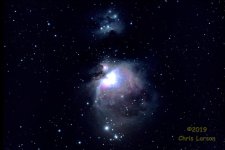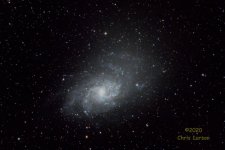You are using an out of date browser. It may not display this or other websites correctly.
You should upgrade or use an alternative browser.
You should upgrade or use an alternative browser.
Astrophotography - Deep Space Objects (DSO)
- Thread starter Moab Man
- Start date
Bikerbrent_RIP
Senior Member
Moab Man. looks pretty impressive a photo to me. Where is the Dumbbell Nebula located in space?
blackstar
Senior Member
I looked, but didn't see a thread for DSO astrophotography.
Dumbbell Nebula
Nikon D7100
3 min exposure - 3 hours total data
Tamron 150-600mm
View attachment 381447
May I ask other than the mentioned camera, lens, exposure, what are other gears (tracker, tripod, telescope, etc.), settings (iso, aperture, etc.) and setup you used to shoot this DSO image? Appreciate.
BF Hammer
Senior Member
Nice job working at 3 hours of exposure data. There are a few threads with m42, Andromeda Galaxy, Triangullum Galaxy, and some others. I know I started a couple, but none have DSO or deep space in the text to search. Just go back 2-4 pages in this subject area.
@blackstar : his telescope was a Tamron 150-600mm lens. Just as I have been using a Sigma 150-600mm. Normally some cropping after unless shooting Andromeda.
@blackstar : his telescope was a Tamron 150-600mm lens. Just as I have been using a Sigma 150-600mm. Normally some cropping after unless shooting Andromeda.
BF Hammer
Senior Member
Here is M42 Orion Nebula and Triangulum Galaxy which I photographed in 2020. I cannot recall the entire exposure time, but I am sure I was shooting less than 60 images at 45 seconds each or perhaps a bit longer. I think I had things dialed in so well on the night of Triangulum that I was shooting 60 second subs.
At the time I shot these with a D750, Sigma 150-600mm C, Manual mode with f/6.3 (wide open for the lens) and I would guess the ISO would be lower with M42 than with Triangulum. Triangulum was not visible to the eye at location, but my goto telescope mount was dialed in perfect and I found it in test photos right away.



Today that setup would be with a new carbon-fiber tripod, Z5 and FTZ-2 adapter, a dew heater wrap on the lens, and a notebook PC tethered to the camera running DigiKamControl. That is a Skywatcher AZ-GTi goto telescope mount that has has the firmware and hardware conversion to run in equatorial mode. It is not certified to track for photography this way, but it works. I also use an aftermarket intervalometer but this function is even better when you can tether a PC with DigiKamControl and see the test images on a larger screen.
At the time I shot these with a D750, Sigma 150-600mm C, Manual mode with f/6.3 (wide open for the lens) and I would guess the ISO would be lower with M42 than with Triangulum. Triangulum was not visible to the eye at location, but my goto telescope mount was dialed in perfect and I found it in test photos right away.



Today that setup would be with a new carbon-fiber tripod, Z5 and FTZ-2 adapter, a dew heater wrap on the lens, and a notebook PC tethered to the camera running DigiKamControl. That is a Skywatcher AZ-GTi goto telescope mount that has has the firmware and hardware conversion to run in equatorial mode. It is not certified to track for photography this way, but it works. I also use an aftermarket intervalometer but this function is even better when you can tether a PC with DigiKamControl and see the test images on a larger screen.
Where is the Dumbbell Nebula located in space?
Constellation Cepheus, shaped like a house. Dumbbell is in the basement.
May I ask other than the mentioned camera, lens, exposure, what are other gears (tracker, tripod, telescope, etc.), settings (iso, aperture, etc.) and setup you used to shoot this DSO image? Appreciate.
- The above gear rode upon my Skyguider Pro with iPolar camera for polar alignment.
- Tripod, home made with angle iron to make it as stiff and heavy as possible - I have a truck bed to throw it in.
- ASIAIR for locating targets and guiding.
- Guide scope Astromania 60mm
- Guide camera ZWO ASI120mm-S
- Cameras used for astro: D850, D500, D600 Astro-modded, and D7100
- Lenses 300mm f/4, Tamron 150-600mm, Tamron 70-200mm, and 1.7 teleconvertor
- Photoshop, Topaz De Noise, Astro Flat
Hope that all helps. Feel free to ask if you want more info or if there is something I missed.

Here is M42 Orion Nebula and Triangulum Galaxy which I photographed in 2020. I cannot recall the entire exposure time, but I am sure I was shooting less than 60 images at 45 seconds each or perhaps a bit longer. I think I had things dialed in so well on the night of Triangulum that I was shooting 60 second subs.
At the time I shot these with a D750, Sigma 150-600mm C, Manual mode with f/6.3 (wide open for the lens) and I would guess the ISO would be lower with M42 than with Triangulum. Triangulum was not visible to the eye at location, but my goto telescope mount was dialed in perfect and I found it in test photos right away.
Today that setup would be with a new carbon-fiber tripod, Z5 and FTZ-2 adapter, a dew heater wrap on the lens, and a notebook PC tethered to the camera running DigiKamControl. That is a Skywatcher AZ-GTi goto telescope mount that has has the firmware and hardware conversion to run in equatorial mode. It is not certified to track for photography this way, but it works. I also use an aftermarket intervalometer but this function is even better when you can tether a PC with DigiKamControl and see the test images on a larger screen.
Thanks for sharing the gear and the photos.
Cool to see the interest in the DSO targets. Love to see others sharing what they have.
Here is the Whirlpool Galaxy M51. From memory, it would have been D500, 300mm with 1.7 tele, 2 min exposures for 2 hours.
View attachment 381465
Here is the Whirlpool Galaxy M51. From memory, it would have been D500, 300mm with 1.7 tele, 2 min exposures for 2 hours.
View attachment 381465
Cool to see the interest in the DSO targets. Love to see others sharing what they have.
Here is the Whirlpool Galaxy M51. From memory, it would have been D500, 300mm with 1.7 tele, 2 min exposures for 2 hours.
View attachment 381465
Invalid attachment George.
Invalid attachment George.
That's funny. I remember this problem. Thank you.
BF Hammer
Senior Member
I took a new try at Andromeda on December 14, 2023. I have photographed it before, poorly.
Camera setup: Z5, Nikkor 70-200mm f/2.8G VR, FTZ-II adapter. Manual f/2.8, 48sec, ISO 3200, zoomed to 200mm.
Mount: SkyWatcher AZ-GTi goto mount with EQ-mode firmware and upgrades. Artcise AS90C tripod
Software: Camera tethered to laptop PC and controlled by DigiCamControl. 77 Raw images stacked and processed in SiRiL, further processing in GIMP.

Camera setup: Z5, Nikkor 70-200mm f/2.8G VR, FTZ-II adapter. Manual f/2.8, 48sec, ISO 3200, zoomed to 200mm.
Mount: SkyWatcher AZ-GTi goto mount with EQ-mode firmware and upgrades. Artcise AS90C tripod
Software: Camera tethered to laptop PC and controlled by DigiCamControl. 77 Raw images stacked and processed in SiRiL, further processing in GIMP.
Nice structure. I'm literally at this moment imaging M42 Orion Nebula.I took a new try at Andromeda on December 14, 2023. I have photographed it before, poorly.
Camera setup: Z5, Nikkor 70-200mm f/2.8G VR, FTZ-II adapter. Manual f/2.8, 48sec, ISO 3200, zoomed to 200mm.
Mount: SkyWatcher AZ-GTi goto mount with EQ-mode firmware and upgrades. Artcise AS90C tripod
Software: Camera tethered to laptop PC and controlled by DigiCamControl. 77 Raw images stacked and processed in SiRiL, further processing in GIMP.
View attachment 399248
Peter7100
Senior Member
FabulousI took a new try at Andromeda on December 14, 2023. I have photographed it before, poorly.
Camera setup: Z5, Nikkor 70-200mm f/2.8G VR, FTZ-II adapter. Manual f/2.8, 48sec, ISO 3200, zoomed to 200mm.
Mount: SkyWatcher AZ-GTi goto mount with EQ-mode firmware and upgrades. Artcise AS90C tripod
Software: Camera tethered to laptop PC and controlled by DigiCamControl. 77 Raw images stacked and processed in SiRiL, further processing in GIMP.
View attachment 399248
Dawg Pics
Senior Member
Very nice dust lanes. I have enough points on Amazon to maybe pay for half of a star tracker. I would like one and a new tripod that I desperately need anyway.I took a new try at Andromeda on December 14, 2023. I have photographed it before, poorly.
Camera setup: Z5, Nikkor 70-200mm f/2.8G VR, FTZ-II adapter. Manual f/2.8, 48sec, ISO 3200, zoomed to 200mm.
Mount: SkyWatcher AZ-GTi goto mount with EQ-mode firmware and upgrades. Artcise AS90C tripod
Software: Camera tethered to laptop PC and controlled by DigiCamControl. 77 Raw images stacked and processed in SiRiL, further processing in GIMP.
View attachment 399248
BF Hammer
Senior Member
I have been watching videos for processing by removing the stars with Starnet++. I revisited my image of Andromeda from December. I added Starnet into the process. I had to move the operation to my laptop PC as the CPU in my main PC is too old to handle Starnet (discovered the hard way). So this time I saved 2 processed images from SiRiL, with and without stars. I then combined them in GIMP. I extracted some more detail and definition of the galaxies without blowing out the stars.

blackstar
Senior Member
Surprise! Comparing the new and old (Dec 23) images I observe the new one not only loses some details but also has the center light of the galaxy blown out... Only the color looks more likable. Are my eyes too old?I have been watching videos for processing by removing the stars with Starnet++. I revisited my image of Andromeda from December. I added Starnet into the process. I had to move the operation to my laptop PC as the CPU in my main PC is too old to handle Starnet (discovered the hard way). So this time I saved 2 processed images from SiRiL, with and without stars. I then combined them in GIMP. I extracted some more detail and definition of the galaxies without blowing out the stars.
View attachment 402493



